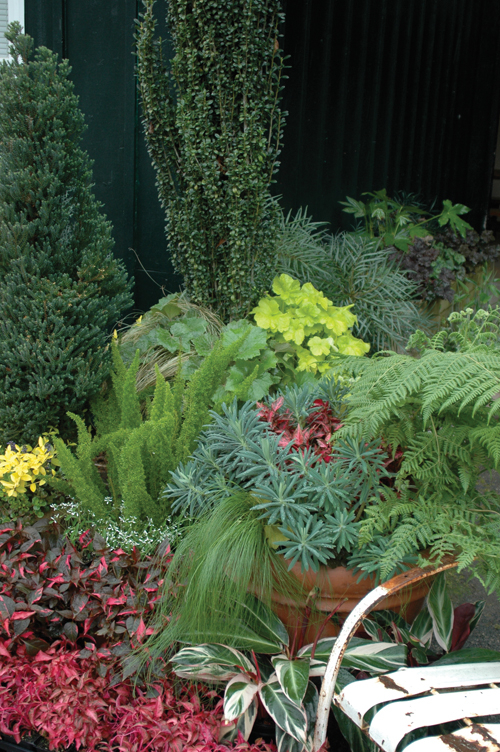
Gardening with Containers
What’s new? As the season changes and the nursery is full with pansies and perennials, landscapers and designers are coming to shop and at least once a day someone asks “What’s new?” There are usually new varieties of plants to offer, but there are also new ways to display plants in the garden.
Containers have been used to add seasonal color on patios, rooftops, at entrances and even table tops as a quick way to decorate with beautiful flower combinations for a special occasion or to add a holiday theme to a porch or outdoor room. Container gardening isn’t what’s new. But instead of “container gardening” with the emphasis on individual pots, the phrase “gardening with containers” describes a trend that incorporates the use of containers in the overall design of the landscape. That’s what’s new.
Choosing the Container
One local designer said, “A garden without containers is like a wall without pictures.” Containers are portable and the contents can be temporary. The style of the vessel can be elegant or whimsical. They can be rearranged and replanted just as pictures can be moved and reframed. Scale is very important when working with either of these scenarios because just as a small picture is lost on a large wall, the most common mistake is using planters that are too small for the landscape. This new trend seems to favor larger containers with a considerable volume of soil, maximizing the versatility of the size and type of plants that can be used for the design. Larger pots may require less maintenance since the plants have room to grow and they don’t dry out as quickly as small pots.
Implementing the Design
The display pots around the office at Saul Nurseries Inc. in Georgia are a good example of “gardening with containers.” Instead of each container displaying a single garden concept the containers are arranged to mimic an above-ground garden with pots of single large trees or shrubs clustered with pots of plant combinations replicating the scale and design of a planted border.
Landscape designers will repeat plant combinations in different areas of a garden or border to keep the style consistent and give the design continuity. A patio with a small adjacent garden or grass area is perfect for using containers to repeat plant combinations. Any perennial or small tree used in the ground in the garden can be repeated in a container on the patio and containers can be placed out in the garden area to repeat combinations in the landscape.
Available Plant Material
Most shrubs and trees are offered to the landscape market in 3-gallon pots or larger. Even though the containers used in the garden tend to be large, this trend opens up a market for premium shrubs and trees to be sold in 1-gallon pots. Unless only one plant is used as a focal point in a pot, the root ball of a 3-gallon plant takes up too much space to accommodate a combination of varieties. Perennials and annuals will tolerate having their roots disturbed much better than woodies when planted, so starting with a 1-gallon plant that is transferred to the container with root ball intact is more successful than trying to bare root a large specimen tree or shrub. Saul Nurseries stocks conifers, Japanese maples, camellias and other evergreen shrubs in 1-gallon pots for use in container gardening.
Adding Containers to the Garden
Three ways of using containers in the landscape are to showcase a special plant and create a focal point, to expand the choice of plant material for the garden and to fill an empty space where little or no soil exists.
Japanese maples are popular and can be used as a focal point in the garden. One variety, Acer ‘Ryusen’, is particularly suited for container use. This maple grows long weeping whips that can be manipulated to any height or shape. The trunk is structurally interesting and the foliage changes from green to a stunning reddish orange in the fall. Planting the tree in a container sets it apart and can also be a way to introduce a smaller plant to the garden before it finds a permanent spot in the ground.
Reblooming perennials in pots can be moved around the garden to spotlight them when in peak bloom. The Echo series of kniphofias can be combined with the coreopsis Cruizin’ series, blending different textures, heights and complementary colors. Using perennials instead of annuals gives the pots a sense of permanence, even though they can be changed with the seasons.
Using large containers can broaden the plant palette of a designer. Not only the use of non-hardy plant material, but also plants that are considered invasive can be incorporated safely into a design. Tropical plants like bananas, elephant ears and alternanthera provide a variety of foliage color that lasts all summer. A new dwarf banana, musa ‘Poquito’, combines well with the brightly colored trailing foliage of alternanthera ‘Mai Tai’ or ‘Partytime’. A large container or group can mimic a seasonal annual bed, or one pot filled with Zone 9 pennisetum ‘Fireworks’ can stand alone as a spectacular display of foliage. Planters can also tame what might be an aggressive plant in the ground. Bamboo, equisetum and even Mariana Maiden Fern up off the ground in a pot can’t escape onto the neighbor’s property. These types of plants used alone in a pot in a landscape can add architectural accents of foliage.
Using Edibles as Ornamentals in Pots
A new ever-bearing raspberry, rubus ‘ItSaul Summer’, can be grown in a large pot placed close by to conveniently harvest the berries without the worry of it rambling through the garden. Citrus trees are also very popular and the portability of a pot is useful to position them so the fragrance of the blooms can be enjoyed and they can be moved inside when the weather turns cold. Even a “salad container” can be placed in a sunny spot to grow a small amount of lettuce, tomatoes and parsley. Herbs like rosemary, lavender and thyme make attractive and fragrant combinations that can be used in a planter in an outdoor kitchen and also repeated out in the garden.
Adding New Elements in Problem Areas
Areas of the landscape where no plants seem to thrive can be repaired by using containers. A blank space under a large tree, or an area that stays wet, can be filled with plants in a container.
An entrance to a garden room may be flanked by two boxwoods or conifers, but the addition of two containers with plants up off the ground can draw attention to the space and guide visitors down the path and through to a new area. Containers can also direct and identify the entrance to a pathway off of a paved area.
Water gardening can also be incorporated into blank areas in the garden. A large vessel with water lilies and lotus, pitcher plants and papyrus add an interesting element to the garden without the maintenance of an in-ground pond.
Permanent Planters in Hardscapes
Finally another new aspect of gardening with containers and maybe the broadest application of this concept is building planters into hardscapes. Planting spaces can be built into walls, by pools and into seating areas on porches or patios. At Saul Nurseries in Alpharetta, Ga., is a wall planted with a wide variety of plants allowing a vertical garden to thrive along a slope by the driveway. It is constructed from a type of cement block that has a hollow front that holds soil and can be planted. Looking straight on, it resembles a checkerboard of planting spaces. Each section is like its own container with the overall design taking on the appearance of a full border.
Selling the Ideas to the Customer
Talk to customers, landscapers and retail garden centers about this new trend and emphasize how containers can be incorporated into the landscape. Plant a display using trees, shrubs and perennial plant combinations, and group planters or have them stand alone showing customers these new ideas. “Gardening with containers” will expand the opportunities you have to offer premium varieties of trees and shrubs for use in containers in 1-gallon pots, bringing the product to the marketplace faster but with a premium price point and not discounted for size because of the new way these plants can be used.









 Video Library
Video Library 


















